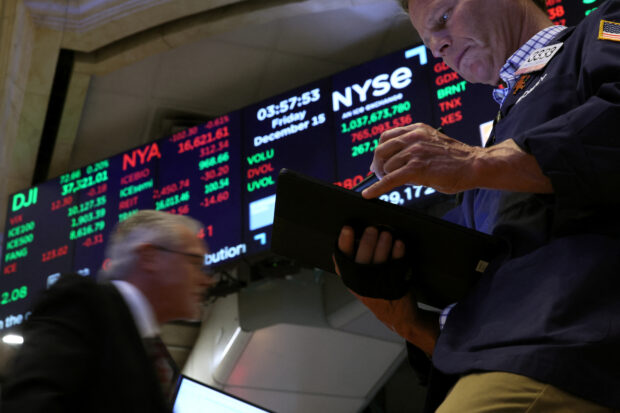S&P 500 ends near record high as AI optimism lifts chipmakers

Traders work on the floor at the New York Stock Exchange (NYSE) in New York City, U.S., Dec 15, 2023. REUTERS/Brendan McDermid/File photo
U.S. stocks ended sharply up on Thursday, with the S&P 500 approaching record highs as AI optimism drove gains in Nvidia and other chipmakers.
U.S.-listed shares of Taiwan Semiconductor Manufacturing (TSMC) soared nearly 10 percent after the world’s largest contract semiconductor maker projected 2024 revenue growth of more than 20 percent on booming demand for high-end chips used in artificial-intelligence applications.
Heavyweight chipmaker Nvidia rose 1.9 percent to a record high, and it was the most-traded company on Wall Street, with almost $28 billion worth of shares exchanged. Rival Advanced Micro Devices rose 1.6 percent and also notched a record high.
Broadcom, Qualcomm and Marvell Technology gained more than 3 percent each. The Philadelphia SE semiconductor index rallied 3.4 percent and approached its December 2023 record high.
“AI has caused this industry to have a ‘rip your face off’ rally, and I don’t think it’s stopping anytime soon,” said Jake Dollarhide, CEO of Longbow Asset Management.
READ: Can sizzling Magnificent Seven trade keep powering US stocks in 2024?
Apple jumped 3.3 percent after BofA Global Research upgraded the iPhone maker’s stock to “buy” from “neutral.” That helped the S&P 500 information technology index rise 2 percent and hit a record high.
The S&P 500 climbed 0.88 percent to end the session at 4,780.94 points. The benchmark is down just 0.3 percent from its record-high close in January 2022.
The Nasdaq gained 1.35 percent to 15,055.65 points, while the Dow Jones Industrial Average rose 0.54 percent to 37,468.61 points.
Data showed the number of Americans filing new claims for unemployment benefits fell last week to a late-2022 low, suggesting solid job growth in January.
Wall Street has wavered in recent sessions as investors became less sure the Federal Reserve will begin cutting interest rates in March.
The S&P 500 lost ground on Tuesday and Wednesday following strong December retail sales data and after policymakers talked down expectations for an early start to rate cuts.
READ: Strong US retail sales underscore economy’s momentum heading into 2024
Traders now see a 56 percent chance for a 25-basis-point rate cut in March, compared with a chance above 80% a month ago, according to the CME Group’s FedWatch Tool.
Interest rate-sensitive sectors dipped, with the S&P 500 real estate index down 0.6 percent and utilities index losing 1.05 percent .
Atlanta Federal Reserve President Raphael Bostic said he was open to reducing rates sooner than he had anticipated if there is “convincing” evidence in coming months that inflation is falling faster than he expected. Bostic had previously said he expected it would be appropriate to cut rates in the second half of 2024.
Humana dropped 8 percent after the health insurer forecast fourth-quarter medical costs to be higher than previously expected. Peer UnitedHealth fell 1.6 percent .
KeyCorp dropped 4.6 percent after the lender posted a decline in fourth-quarter profit, while Birkenstock sank about 8 percent after missing quarterly profit expectations.
Spirit Airlines ended down more than 7 percent after news it is looking at options to refinance its debt and is not considering restructuring.
READ: US judge blocks JetBlue from acquiring Spirit Airlines
Advancing issues outnumbered falling ones within the S&P 500 by a two-to-one ratio.
The S&P 500 posted 30 new highs and seven new lows; the Nasdaq recorded 56 new highs and 180 new lows.
Volume on U.S. exchanges was relatively heavy, with 11.8 billion shares traded, compared with an average of 11.5 billion shares over the previous 20 sessions.